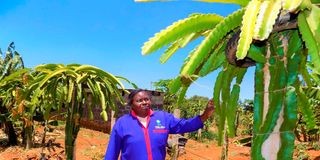Expert ventures into dragon fruit farming

Dr Monicah Waiganjo at hear orchard in Kithimani.
Some two kilometres from Kithimani Town, behind Club Target in Yatta, Machakos County, is a two-acre orchard, with about 1,500 dragon fruit trees. We meet Dr Monicah Waiganjo, the owner.
“I first saw and the fruit at a friend’s kitchen garden in April 2021 and loved its colour and mild taste. It is a red juicy and fleshy fruit with crunchy seeds. It reminded me of the Kiwi fruit,” she says.
Dr Waiganjo – who worked as a scientist and administrator at Kenya Agricultural and Livestock Research Organisation (Kalro) for 40 years – was determined to learn about the fruit.
She visited farms in Kenya, Vietnam, China, Malaysia, Indonesia, the Philippines and India.
“I also read widely about dragon fruit production, processing and marketing. By the end of May 2021, I had visited many growers, bought cuttings and established an orchard with dragon fruit, papaya, avocado, macadamia, banana and mangoes,” she says.
Dry tropical regions
Dragon fruit does well in particular soils.
“The crop adapts to most climatic conditions in Kenya but prefers dry tropical regions with average temperatures of 21 to 30 degrees Celsius and rainfall of 500–1500mm. Sandy soils are ideal,” she says.
Grown in cooler regions, the dragon fruit takes long to mature and is not as sweet as that grown in dry areas.
In establishing an orchard, it is important have disease-free, rooted cuttings. The farmer should also have posts for supporting the plants. In Dr Waiganjo’s case, one post supports three dragon fruit plants.
“The dragon fruit plant is a climber and requires a strong vertical post-support, preferably seven feet. The farmer can use a ring of used motorcycle tyres to hold the tree to the post. Avoid metals,” she says.

Dr Monica Waiganjo displays her dragon fruits at Kithimani in Machakos County on February 27, 2023.
“Care should be taken when selecting the support posts as they should be strong, preferably concrete. A post should be able to carry a weight of up to 200 kilos.”
The scientist says the cuttings are rare, making them expensive. One goes for Sh500 to Sh1,000.
The dragon fruit crop requires little water. Even when fully established, it can survive without water for weeks or even months. Dr Waiganjo, however, advises farmers to water their dragon fruit plants every week.
Vertical growth
To allow fast vertical growth, remove the shoots of the climbing stems, leaving just one or two until they reach six inches from the top of the support.
Once the tree is established, prune regularly to obtain an open manageable and productive umbrella shape canopy.
“Regular pruning and pruning right after harvesting induces new shoots for the next cropping season,” she says, adding that pruning allows air to circulate freely in the orchard.
Dr Waiganjo’s first harvest was 30kgs. It sold almost immediately, motivating her to grow more dragon fruit trees as demand was definitely high. She sold a kilo at Sh800.
Dr Waiganjo says the fruit has many nutritional benefits and can be grown by smallholder farmers, even in urban areas. A tree can be productive for up to 50 years.
“Dragon fruit has a ready market locally and internationally. The economic returns are also high. Fortunately, very few pests and diseases attack dragon fruit trees,” she says.
“Under refrigeration, the fruit remains fresh for two months. Dragon fruits can be processed into juice and even wine. The peels can be used as beverage while the flower buds are vegetables.”





